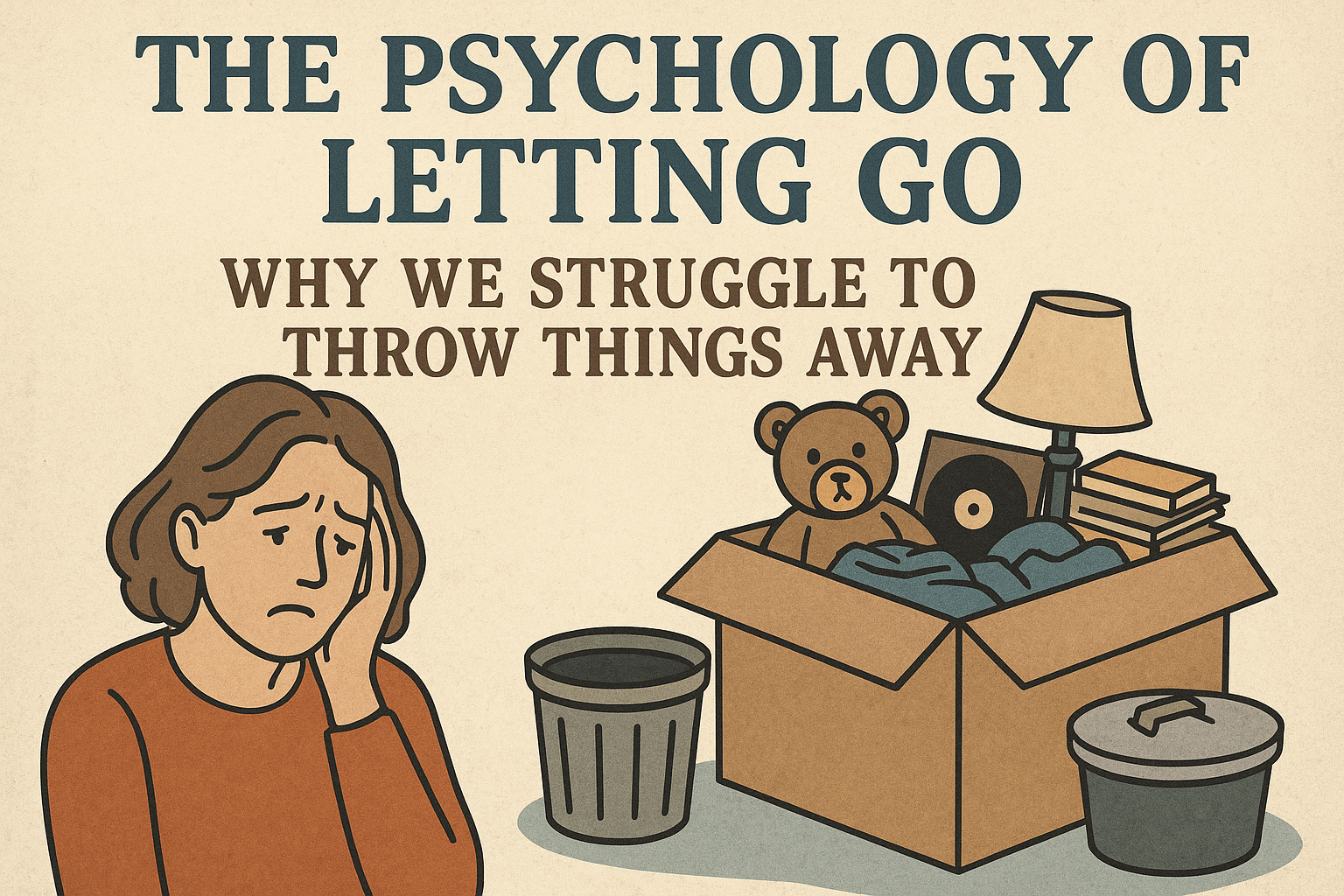
The psychology of letting go reveals why we often find it so difficult to part with the items we’ve accumulated over time. Our possessions become extensions of our identity, tightly woven with memories, emotions, and personal history. This emotional attachment can prevent us from discarding things—even when they serve no functional purpose—leading to clutter that reflects our inner emotional state.
Letting go is not just about clearing physical space. It’s a process of emotional decluttering, helping us release the past and make room for a more peaceful, intentional way of living.
Key Takeaways
- Our possessions reflect identity and emotions.
- Emotional clutter impacts decision-making and wellbeing.
- Letting go is a psychological process, not just physical.
- Decluttering promotes mental clarity and peace.
- Mindful habits can ease the emotional burden of decluttering.
Why We Hold On: Emotional Attachment to Things

Objects can represent memories, achievements, relationships, and even aspirations. This emotional significance often makes it hard to part with them.
Understanding the psychology of letting go helps explain why we hold onto things that no longer serve us. It’s not just about sentimentality—it’s about how deeply objects intertwine with our identity.”
How Items Reflect Identity
Possessions like inherited jewellery or a favourite old book are more than just things—they’re reflections of who we are or once were. Letting them go can feel like letting go of a part of ourselves.
The Stories Behind Belongings
Each item in our home tells a story. A holiday souvenir may remind us of a happy time; a child’s toy might recall early parenthood. Recognising these narratives helps us make intentional choices about what we keep.
The KonMari method helps people ask what truly sparks joy—learn more about this globally recognised method.
What Is Emotional Clutter?
Emotional clutter refers to persistent, unresolved thoughts and feelings that weigh us down—grudges, regrets, old traumas, or outdated beliefs.
The psychology of letting go also applies to the mental baggage we carry. Emotional clutter, such as unresolved feelings or outdated beliefs, can manifest in our physical spaces too.
It often shows up as:
- Difficulty making decisions
- Constant mental fatigue
- Sleep disturbances
- Relationship tension
- Chronic anxiety
As seen in the table below, emotional clutter has very real effects:
| Sign of Emotional Clutter | Effect on Life |
|---|---|
| Feeling overwhelmed | Reduced mental clarity |
| Indecisiveness | Poor decision-making ability |
| Persistent worry | Heightened anxiety |
| Sleep issues | Weakened physical health |
The Hidden Reasons Behind Clutter
Some behaviours stem from deeper fears and subconscious patterns that need to be acknowledged before change can happen.
Fear of Scarcity
People often hold onto items “just in case.” This scarcity mindset is rooted in fear of future lack, often originating from past trauma or financial instability.
| Mindset | Scarcity | Abundance |
|---|---|---|
| Belief System | “What if I need this later?” | “I can get it again if needed.” |
| Decluttering Habit | Hoards items due to fear of loss | Releases freely with confidence |
Nostalgia and Memory
Many struggle with letting go of items tied to special memories. The key is understanding that the memory doesn’t live in the object—it lives in you. Consider capturing the memory digitally through a photo or journaling.
Clutter’s Impact on Mental Health
Physical clutter is closely linked to psychological stress. Cluttered spaces often reflect a cluttered mind.
How Clutter Causes Stress
- Activates cortisol production (the stress hormone)
- Makes relaxation harder
- Distracts focus
- Decreases productivity
Space Reflects State of Mind
Our homes and environments mirror our mental state. A tidy space often correlates with clarity, while clutter can trigger emotional exhaustion.
Practical Emotional Decluttering Steps
Here’s how to take action:
Step 1: Identify Emotional Triggers
Track emotional responses for two weeks. Note:
- What item or situation caused the feeling
- What emotion arose
- Where you felt it physically
- Who was involved
This will reveal patterns and help you plan targeted decluttering.
Step 2: Try the KonMari Method
Ask yourself: “Does this spark joy?” If the answer is no—and it doesn’t serve a clear purpose—thank it, and let it go.
Step 3: Set Boundaries
Learn to say no to accumulating unnecessary items. Also, evaluate whether relationships or obligations in your life are adding to your emotional clutter.
Mindful Decluttering Techniques
Mindfulness helps us detach from objects gently and with appreciation.
Practising gratitude and mindfulness aligns closely with the psychology of letting go. These strategies allow us to release items with intention, rather than guilt or anxiety.
Gratitude Before Letting Go
Before discarding an item, acknowledge its role in your life. Thank it. This makes the release more peaceful and less jarring.
Create Releasing Rituals
Some people write goodbye notes to sentimental items. Others create memory boxes or take photos before letting go. These simple acts bring closure.
Try this calming exercise: Close your eyes. Identify where in your body you feel the emotional tension. Inhale for 4 counts, exhale slowly. Picture the feeling drifting away with your breath. Repeat as needed.
Teaching Children About Letting Go
Decluttering is a valuable life skill that nurtures emotional intelligence.
Age-Based Activities
| Age | Activity | Learning Outcome |
|---|---|---|
| 3–5 years | Sort toys into “keep,” “donate,” “recycle” piles | Understanding decisions and categories |
| 6–10 years | Choose clothes and toys to let go | Develops decision-making and gratitude |
| 11+ years | Manage their own room decluttering | Builds independence and self-regulation |
Role Modelling from Parents
Children copy adults. Show them how to value things—but not be ruled by them. Talk openly about how you let go of things that no longer serve you.
Conclusion: Letting Go to Lighten Up
Letting go is more than a tidy drawer or clean shelf—it’s about releasing emotional weight. When we understand the psychology of letting go, we empower ourselves to create space for joy, creativity, and peace.
Sometimes, emotional relief begins with quick wins—like same day rubbish removal services to jumpstart the process.
Emotional decluttering helps us:
- Improve mental wellbeing
- Live intentionally
- Cultivate healthier relationships with objects and people
Start small. Begin with one item, one story, one goodbye. Each step is a move toward a lighter, more purposeful life.

 CALL NOW
CALL NOW